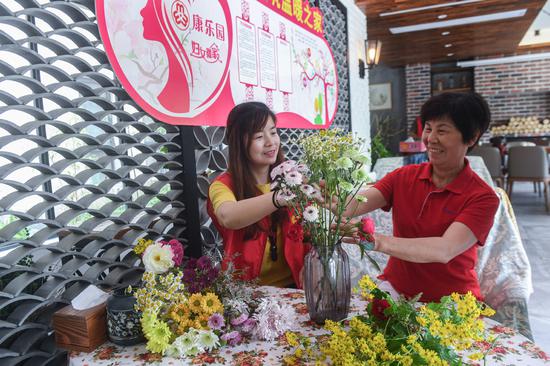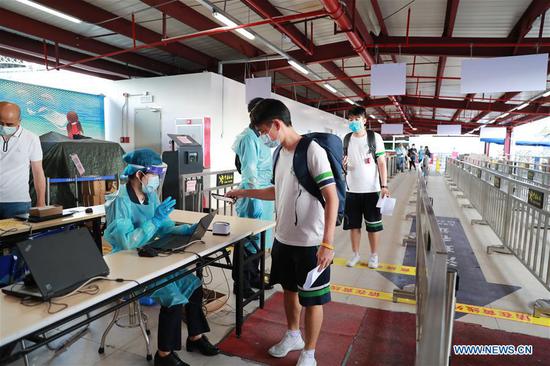
Trainer Amir Esalat livestreams a gym class from his home in Teheran.
The Bank of Iran said funds would be made available as soon as it received a request from the health ministry and related authorities.
Two weeks later, Iranian President Hassan Rouhani said the country would allocate 20 percent of the annual state budget to fight the outbreak.
The equivalent of $23.75 billion, the allocation includes grants and low-interest loans for those affected by the pandemic. However, it is far from sufficient to enable to Iran to get through such a challenging time, especially amid economic sanctions from the United States.
Iranian Foreign Minister Mohammad Javad Zarif said the sanctions, reimposed after the US unilaterally withdrew from the 2015 nuclear deal in May 2018, have drained his country's economic resources and impaired its ability to fight the pandemic.
The sanctions restrict global trade with Iran, affecting its crude oil sales, banking and other industries.
Iran has called many times for a global campaign for the measures to be ignored. "They (the sanctions) literally kill innocents," Zarif said.
Help from China
Just a week after the first two COVID-19 cases were diagnosed in Iran, the Peaceland Foundation, a nongovernmental rescue organization, sent the first batch of 1,000 nucleic acid test kits from China to Iran on Feb 25.
In the coming days, the second batch arrived, and on March 7, the foundation delivered the third, consisting of 2,500 rapid detection reagents, to the Iranian embassy in Beijing, followed by a fourth batch on March 16.
Wang Ke, who founded the organization, which sent a team to Iran in April last year to help deal with flooding, said, "We learned about the situation in Iran from the news and thought we could help, so we contacted the embassy to see what was needed."
He immediately got in touch with factories and companies producing personal protective equipment, disinfection materials and test kits.
Many people he reached were "very supportive", and provided the goods and materials free of charge. "They knew that if the virus spread wildly overseas, it would in turn place huge pressure on China," Wang said.
Since March 5, another nonprofit social organization, the China-Arab Exchange Association, has donated eight aid packages to Iran worth a total of more than 2 million yuan ($282,000).
Chen Xinhui, the association's secretary-general, said, "Iran sent a military aircraft to help us fight the virus when it heard about the outbreak (in China). So, when we saw the same thing happen to Iran, we thought of helping them.
"The biggest difficulty we faced was a shortage of materials. Although the outbreak in China has basically been under control since March, there was still a gap between production and supply."
Chen and his colleagues raised a considerable amount of aid, including various types of personal protective equipment, detection reagents and disinfectant.
Iranian Foreign Ministry spokesman Seyed Abbas Mousavi said the first consignment sent to Iran by the Chinese government and the Red Cross, which included about 20,000 coronavirus test kits and other supplies, reached the country on Feb 28.
On March 14, Mousavi said, "The process of receiving generous assistance from people in China is continuing, and at present, a large amount of aid-about 32,000 kilograms of various supplies-has been packed and is going to be shipped to Iran on the next flights."
The Communist Party of China's International Liaison Department has sent a shipment of medicine, N95 respiratory masks and disposable face masks to Iran.
The department's head, Song Tao, said in a letter to the Secretary of Iran's Expediency Council, Mohsen Rezaei, that China was ready to launch scientific cooperation and share its experience with Iran in the battle against the virus.
On April 16, Zarif, the Iranian foreign minister, published a "thank-you note" in Chinese on his Twitter account.
The note stated, "I thank China for providing Iran with anti-epidemic materials, sending medical experts, and condemning the continued illegal sanctions by the United States that have seriously hindered Iran's efforts to fight the epidemic."
Threat not over
Although Iran remains one of the countries in the Middle East hardest hit by the virus, the number of new daily cases has fallen, triggering hopes that the country may be turning the tide.
On April 22, Iranian Health Minister Saeed Namaki said that in the previous 18 days, "thanks to divine blessing as well as the efforts of our colleagues ... we were able to reduce the number of new patients by 53 percent and the death toll by 30 percent daily".
Iranian government spokesman Ali Rabiee also said the infection rate and the number of deaths from COVID-19 are falling in Iran.
However, Iraj Harirchi, deputy minister of health, said a decline in the number of cases in the hardest-hit provinces, such as Qom and Gilan, does not mean that the threat is over, but that precautionary measures must continue to avert a new peak.
"Until further notice, a second, third and umpteenth peak is quite probable throughout the world, even in countries that are apparently clear (of the virus)," he said.
Harirchi added that people must get used to living with the virus and should observe health advice and social distancing regulations until a vaccine is produced.
He said the health ministry had launched the second stage of nationwide screening programs, with more than 99 percent of the population covered in the first stage.
Rabiee said, "We must live with social distancing and follow instructions until the day the health ministry announces that the virus has been defeated."


















































